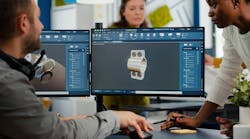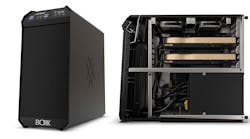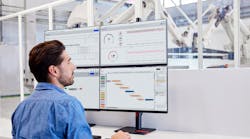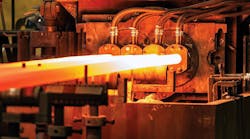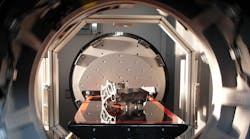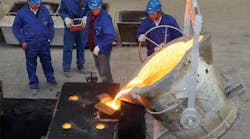Manufacturing has turned the corner. Economic recovery has transitioned from wishful thinking to foreseeable reality. In metacasting, as in nearly all manufacturing sectors, plant managers are less likely to be fretting over idle machines and more likely to be monitoring the flow of new orders, trying to decide how and when to bring mothballed lines back up to speed. Operations managers are retooling for new products, new waves of orders—and new, higher levels of customer expectations.
It’s go time. While procurement officers are expanding their global networks of suppliers and talent managers are recruiting to fill skill gaps, the IT manager also has to complete some “get-ready” tasks. In order to be well positioned to seize the emerging opportunities on the horizon, end-to-end systems and process workflows need to be finely tuned and ultra-efficient.
A recent IDC report referred to this adjustment phase as a “transformation journey” and called for “manufacturers to undertake a major rethinking of their business models.”1
Nanoseconds, not minutes, now need to be measured. Fractions of cents, not dollars, must be considered in every bid, every profit analysis and every calculation of return on investment. And, not to be underestimated, today’s global economy requires an expanded, multi-lingual reality-check of customers, contractors, suppliers—and fierce competitors, hungry for your piece of the pie chart.
Basic data management functionality, which may have sufficed in the last decade, is now seriously ill-equipped to manage this complex and highly competitive environment. As 2020 approaches, the delta between old and new technologies will depict an ever steeper difference, the ultimate hockey-stick profile. As technologies that were recently called “disruptive” move into the “been-there-done-that” category, laggard companies risk falling so far behind that catch up is impossible.
Metalcasting is at that point. In order to compete in the “Manufacturing 3.0” world, foundries and diecasters must adopt the information technology that speaks that language—the language of agility, analytics, mobility, social, cloud, configuration and collaboration. In the IDC report, analyst Lorenzo Veronese calls this the “Third IT Platform” and explains that in order to reach this level, profound changes to the business model will be required, including moving from a transactional business approach to one that is purely “real-time.”
Veronese writes: “Manufacturers will have to break organizational silos, create a more collaborative working environment, get closer to customers, and leverage modern IT, which will enable them to operate at the speed of the marketplace.”
Accessibility, and Beyond
As that speed continues to accelerate, now is the optimal time to take inventory of existing strengths and identify gaps in functional capabilities, before you are forced into a reactive emergency mode, rather than a calm, proactive approach. Although an objective self-analysis can be difficult to do, it is the critical starting point for choosing new paths. Consider these guidelines as you build an infrastructure based on the emerging principles of the New Manufacturing Age:
Accessible — Your ERP solution must be accessible by your workers—where, when, and how they want to consume the information. That doesn’t always involve sitting at a desk in front of a PC. Many ERP users are on the go, work from the plant and rely on connectivity with coworkers or real-time data no matter their place or time.
Users should be able to reach the data they need while in the plant, with customers, in the field, in the warehouse, collaborating with engineers, meeting with suppliers or distributors, at branch offices, or even the offices of contractors or customers.
Consumable — Data must be digestible. It must be available in a format that can be understood easily and applied to different situations. Today’s millennial-age workforce has high standards. As the generation that grew up with a smart phone in hand, they insist on highly intuitive screens, contextual informative and easy navigation.
Collaborative — This is another must for the generation that socializes about every serious (and not so serious) decision. It is in their nature to “check in” with customers on project milestones, “follow” product innovation threads, “capture” critical turning points in team efforts and “like” or “poke” colleagues as a natural part of their communication style.
If you want to fully engage this millennial worker, your software needs to support their mindset.
Global — Your IT infrastructure must be able to stretch across a wide playing field. This means it must be multi-language, multi-currency, and have international regulation-tracking capabilities. If you are only focusing on your front yard, you are bound to be crushed by a competitor who sneaks up and attacks from behind.
Widen your scope, including widening the footprint of your ERP capabilities.
Cloud-based — Cloud deployment is the future of manufacturing ERP. It makes sense. Not only does it offer a lower total cost of ownership, it also allows faster implementation and greater agility. You can have a new branch or division up and running in hours, not months. This is the kind of agility that will be required to survive in our highly competitive landscape.
Flexible — Above all, the ERP solution of the future is one that is highly flexible and adapts easily to changing needs. The architecture should allow for expansion and integration to new applications as they become available or are needed. Today, flexible ERP solutions allow loosely coupled data to be stored and retrieved from multiple locations—without breaking other links.
These “must-have” capabilities for your ERP solution provide a basic roadmap. They are the starting points for an integrated IT infrastructure that is well-prepared for the future—no matter what innovations may be ahead. Although the future is a mystery, some predictions are fairly safe. Market conditions are changing and will continue to evolve at escalating rates, we can say with almost certainty. And, with equal commitment, we can predict that technology will be a critical factor in competing in this new era, “Manufacturing 3.0.”
Mark Humphlett is the Industry and Solution Strategy Director for Infor. Contact him at [email protected]; or, visit www.infor.com


